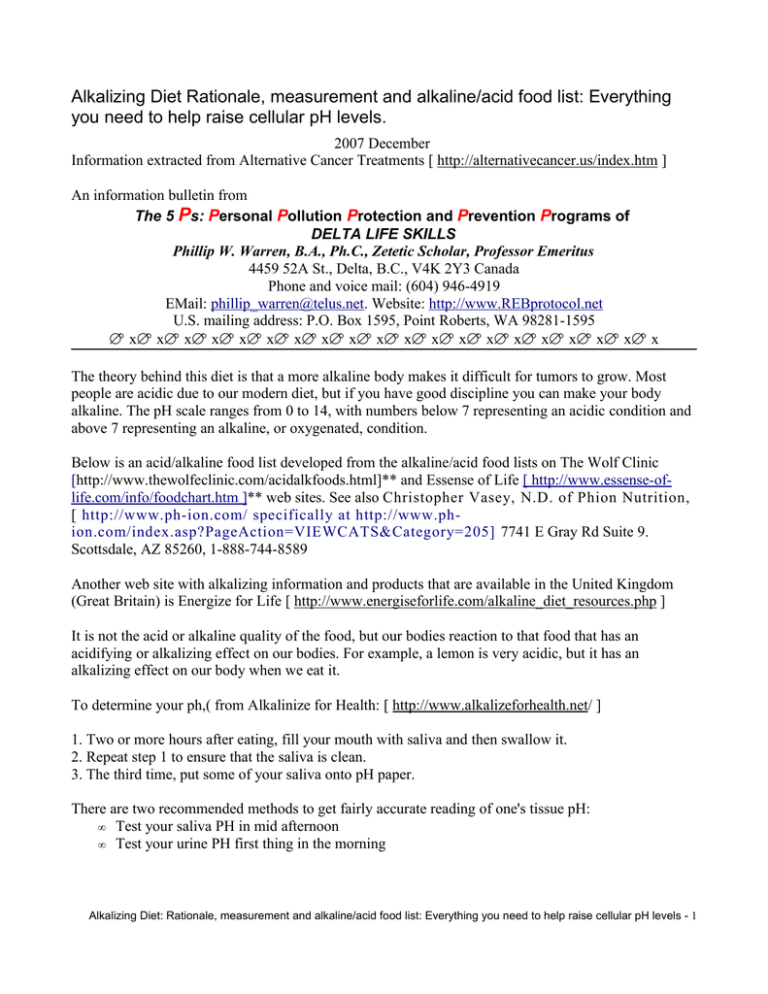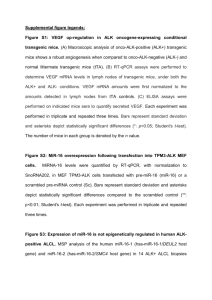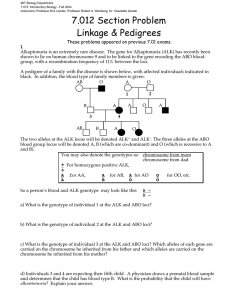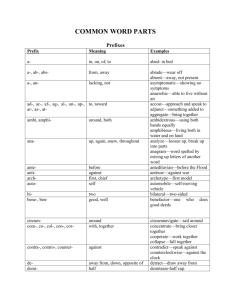Alkalizing Diet Rationale, measurement and alkaline/acid food list: Everything
advertisement

Alkalizing Diet Rationale, measurement and alkaline/acid food list: Everything you need to help raise cellular pH levels. 2007 December Information extracted from Alternative Cancer Treatments [ http://alternativecancer.us/index.htm ] An information bulletin from The 5 Ps: Personal Pollution Protection and Prevention Programs of DELTA LIFE SKILLS Phillip W. Warren, B.A., Ph.C., Zetetic Scholar, Professor Emeritus 4459 52A St., Delta, B.C., V4K 2Y3 Canada Phone and voice mail: (604) 946-4919 EMail: phillip_warren@telus.net. Website: http://www.REBprotocol.net U.S. mailing address: P.O. Box 1595, Point Roberts, WA 98281-1595 ∆∞x∆∞x∆∞x∆∞x∆∞x∆∞x∆∞x∆∞x∆∞x∆∞x∆∞x∆∞x∆∞x∆∞x∆∞x∆∞x∆∞x∆∞x∆∞x∆∞x The theory behind this diet is that a more alkaline body makes it difficult for tumors to grow. Most people are acidic due to our modern diet, but if you have good discipline you can make your body alkaline. The pH scale ranges from 0 to 14, with numbers below 7 representing an acidic condition and above 7 representing an alkaline, or oxygenated, condition. Below is an acid/alkaline food list developed from the alkaline/acid food lists on The Wolf Clinic [http://www.thewolfeclinic.com/acidalkfoods.html]** and Essense of Life [ http://www.essense-oflife.com/info/foodchart.htm ]** web sites. See also Christopher Vasey, N.D. of Phion Nutrition, [ http://www.ph-ion.com/ specifically at http://www.phion.com/index.asp?PageAction=VIEWCATS&Category=205] 7741 E Gray Rd Suite 9. Scottsdale, AZ 85260, 1-888-744-8589 Another web site with alkalizing information and products that are available in the United Kingdom (Great Britain) is Energize for Life [ http://www.energiseforlife.com/alkaline_diet_resources.php ] It is not the acid or alkaline quality of the food, but our bodies reaction to that food that has an acidifying or alkalizing effect on our bodies. For example, a lemon is very acidic, but it has an alkalizing effect on our body when we eat it. To determine your ph,( from Alkalinize for Health: [ http://www.alkalizeforhealth.net/ ] 1. Two or more hours after eating, fill your mouth with saliva and then swallow it. 2. Repeat step 1 to ensure that the saliva is clean. 3. The third time, put some of your saliva onto pH paper. There are two recommended methods to get fairly accurate reading of one's tissue pH: • Test your saliva PH in mid afternoon • Test your urine PH first thing in the morning Alkalizing Diet: Rationale, measurement and alkaline/acid food list: Everything you need to help raise cellular pH levels - 1 The pH of the saliva should be slightly more alkaline than that of the urine. A healthy pH for saliva fluctuates somewhere between 6.6 - 7.0. Urinary pH is always more acidic than the saliva. A normal urinary pH reading in the morning should be somewhere between 6.0-6.4 while in the evening hour a healthy range is considered to be somewhere between 6.4 - 6.8. You need narrow range pH paper measuring pH 4.5 to 7.5 or pH 4.5 to 8.5. One source is Micro Essential Laboratory Inc., Brooklyn, N.Y. 11210 telephone 718-338-3618. See also Phion Nutrition, [ http://www.ph-ion.com/ ] 7741 E Gray Rd Suite 9. Scottsdale, AZ 85260, 1-888-7448589 See Manufacturers on the Cesium Chloride page on Alternative Cancer Treatments [ http://alternativecancer.us/cesiumchloride.htm#Man ] WARNING (from Essense of :Life) - People who use an alkalizing diet often take cesium chloride to further increase alkalizing of their body. Cesium chloride can deplete your body of potassium. Many of these people take potassium supplements while taking cesium chloride. Some people eat bananas to increase their potassium intake. One medium banana has about 450 mg. The amount of potassium you need may vary, but athletes who sweat a lot need up to 4000 mg a day of potassium. This is a lot of potassium so you may want to consider purchasing the liquid form [ http://www.essense-oflife.com/info/potassium.htm ] ** distributed by Essense-of Life which seems to be the highest concentration available. Potassium deficiency causes: • Fatigue • Mental confusion • Irritability • Heart disturbances Potassium is used in the body for: • Water balance and distribution • Acid-base balance • Muscle and nerve cell function • Heart function • Kidney and adrenal function Cancer and pH Cancer begins when a cell reproduces for no obvious reason and is not receptive to the normal signal to stop reproducing. This unchecked growth spreads through the body and interferes with the ability of the body and its cells, organs, and other structures to perform their normal functions. Otto Warburg won a Nobel prize for showing that cancer thrives in anaerobic (without oxygen), or acidic, conditions. Research by Keith Brewer, PhD ** and Tullio Simoncini **, has shown that raising the pH (oxygen content) range of a cell to 8.0 creates a deadly environment for cancer. The pH scale ranges from 0 to 14, with numbers below 7 representing an acidic condition and above 7 representing an alkaline, or oxygenated, condition. High pH therapy raises the pH, or oxygen content, of the cancer cell. The cells that die are absorbed and eliminated by the body. **[see papers under the category "Papers on nutrition and the importance of pH balance (using diet, bicarbonate of soda, hydrogen Alkalizing Diet: Rationale, measurement and alkaline/acid food list: Everything you need to help raise cellular pH levels - 2 peroxide - H2O2)" on http://www.REBprotocol.net] High pH Therapy has been used as an alternative or complementary cancer treatment or therapy for breast cancer, lung cancer, prostate cancer, colon cancer, pancreatic cancer, liver cancer, skin cancer, ovarian cancer, stomach cancer, cervical cancer, brain cancer, kidney cancer, testicular cancer, bone cancer, throat cancer, thyroid cancer, gastrointestinal cancer, cancers of the bladder and gallbladder, metastatic melanoma, and cancers in animals including feline, canine, and equine cancer. ALKALINE/ACID FOOD LIST Acidifying Foods (Avoid) Alcohol including wine. Dairy except organic unpasteurized milk and Cottage cheese. Grains except millet. Meat including fish except for white meat chicken and eggs. Nuts except for almonds and chestnuts. Oils including olive oil. Natural and artificial Sweeteners except Stevia Alkalizing Foods (Good) Fruits except Cranberries. Vegetables except potatoes White meat chicken and eggs. Spices including salt and all herbs. Sources The lists are a compilation of information taken from two web sites: The Wolfe Clinic web site at: http://www.thewolfeclinic.com/index.html and the Essense-of-Life web site at: http://www.essense-of-life.com/index.htm PH Range and Significance: 7.0 to 7.5+ is healthy 6.0 to 6.5 could develop disease 4.5 to 5.5 disease may be present WARNING - an alkalizing diet will deplete your body of potassium. You must take potassium supplements while on this diet. The amount of potassium you need many vary, but athletes who sweat a lot need three or four grams (1000 mg) a day of additional potassium. Extremely Alkaline Lemons, Watermelon Strongly Alkaline Alkalizing Diet: Rationale, measurement and alkaline/acid food list: Everything you need to help raise cellular pH levels - 3 Asparagus, Cantaloupe, Cayenne, Celery, Dates, Figs, Fruit Juices, Grapes (sweet), Kelp, Kiwifruit, Limes, Mango, Melons, Papaya, Parsley, Passionfruit, Pears (sweet), Pineapple, Raisins, Seaweeds, Seedless Grapes (sweet), Umeboshi Plums, Vegetable Juices, Watercress Moderately Alkaline Alfalfa Sprouts, Apples (sour), Apples (sweet), Apricots, Avocados, Bananas (ripe), Beans (fresh, Beets, Bell Peppers, Broccoli, Cabbage, Carob, Cauliflower, Currants, Dates, Figs (fresh), Garlic, Ginger (fresh), Grapefruit, Grapes (less sweet), Grapes (sour), green), Guavas, Herbs (leafy green), Lettuce (leafy green), Lettuce (pale green), Nectarine, Oranges, Peaches (less sweet), Peaches (sweet), Pears (less sweet), Peas (fresh, Peas (less sweet), Potatoes (with skin), Pumpkin (less sweet), Pumpkin (sweet), Raspberries, Sea Salt (vegetable), Squash, Strawberries, Sweet Corn (fresh), sweet), Turnip, Vinegar (apple cider) Slightly Alkaline Almonds, Artichokes (Jerusalem), Brussel Sprouts, Cherries, Chestnuts (dry, Coconut (fresh), Cow's Milk and Whey (raw), Cream (fresh, Cucumbers, Eggplant, Eggs, Goat's Milk and Whey (raw), Honey (raw), Leeks, Margarine, Mushrooms, Neutral Butter (fresh, Oils (except olive), Okra, Olive Oil, Olives (ripe), Onions, Pickles (homemade), Poultry (white meat), Radishes, raw), roasted), Sea Salt, Sesame Seeds (whole), Soy Beans (dry), Soy Cheese, Soy Milk, Spices, Sprouted Grains, Tofu, Tomatoes (less sweet), Tomatoes (sweet), unsalted), Vinegar (sweet brown rice), Yeast (nutritional flakes), Yogurt (plain) Moderately Acidic Adzuki, Bananas (green), Barley (rye), Beans (mung, Dry Coconut, Fructose, garbanzo), Blueberries, Bran, Butter, Cereals (unrefined), Cheeses, Crackers (unrefined rye, Cranberries, Goat's Milk, Honey (pasteurized), Ketchup, kidney, Maple Syrup (unprocessed), Milk (homogenized), Molasses (un-sulfured and organic), Most Nuts, Mustard, Oats (rye, Olives (pickled), organic), Pasta (whole grain), Pastry (whole grain and honey), pinto, Plums, Popcorn (with salt and/or butter), Potatoes, Prunes, Rice (basmati and brown), rice and wheat), Seeds (pumpkin, Soy Sauce, sunflower), Wheat Bread (sprouted organic) Extremely Acidic Artificial Sweeteners, Beef, Beer, Breads, Brown Sugar, Carbonated Soft Drinks, Cereals (refined), Chocolate, Cigarettes and Tobacco, Coffee, Cream of Wheat (unrefined), Custard (with white sugar), Deer, Drugs, Fish, Flour (white wheat), Fruit Juices with Sugar, Jams, Jellies, Lamb, Liquor, Maple Syrup (processed), Molasses (sulfured), Pasta (white), Pastries and Cakes from White Flour, Pickles (commercial), Pork, Poultry (dark meat), Sugar (white), Table Salt (refined and iodized), Tea (black), White Bread, White Vinegar (processed), Whole Wheat Foods, Wine, Yogurt (sweetened) Alkalizing Diet: Rationale, measurement and alkaline/acid food list: Everything you need to help raise cellular pH levels - 4 Alphabetical Listing (alk = alkalizing, acid = acidifying) Alfalfa- alk Alkaline Antioxidant- alk Almond Milk - acid Almonds- alk Amaranth - acid Apple- alk Apple Cider Vinegar- alk Apricot- alk Asparagus - alk Avocado- alk Avocado Oil - acid Banana (ripe) - alk Banchi Tea- alk Barley - acid Barley Grass- alk Beans - acid Bee Pollen- alk Beef - acid Beer - acid Beets- alk Berries (not cranberry)- alk Black Beans - acid Brazil Nuts - acid Broccoli- alk Brussel- alk Buckwheat - acid Butter - acid Cakes - acid Cabbage- alk Canola Oil - acid Cantaloupe- alk Carrot- alk Cashews - acid Cauliflower- alk Celery- alk Chard- alk Cheese - acid Chemicals - acid Cherries - alk Chestnuts - alk Chick Peas - acid Chicken Breast- alk Chili Pepper- alk Chlorella - alk Cinnamon - alk Clams – acid Coffee - acid Collard Greens - alk Corn - acid Corn Oil - acid Cottage cheese - alk Cranberries - acid Cucumber - alk Currants - alk Curry - alk Daikon - alk Dandelions - alk Dates - alk Drugs (most) - acid Dulce - alk Edible Flowers - alk Eggplant - alk Eggs - alk Figs - alk Fish - acid Flax Oil - acid Flax Seeds - alk Flour except millet flour acid Fruit Juice unsweetened alk Garlic - alk Ginger - alk Ginseng Tea - alk Grapefruit - alk Grapes - alk Green Juices - alk Green Peas - acid Green Tea - alk Greens - alk Hard Liquor - acid Hemp Seed - acid Herbal Tea - alk Herbs - alk Honeydew - alk Kale - alk Kamut - acid Kidney Beans - acid Kohlrabi - alk Kombu - alk Kombucha - alk Lamb - acid Lard - acid Lecithin Granules - alk Lemon - alk Lentils - acid strong acidifying Lettuce - alk Lima Beans - acid Lime - alk Lobster - acid Macaroni - acid Maitake - alk Melon - alk Milk - acid Milk organic unpasteurized - alk Millet - alk Mineral Water - alk Miso - alk Mushrooms - alk Mussels - acid Mustard - alk Nectarine - alk Noodles - acid Nori - alk Oats - acid Oil - acid Olive Oil - acid Onions - alk Orange - alk Oyster - acid Parsnips (high glycemic) alk Peach - alk Peanuts - acid Pear - alk Peas - alk Pecans - acid Peppers - alk Pineapple - alk Pinto Beans - acid Pork - acid Potatoes - acid Powder - alk Probiotic Cultures - alk Pumpkin - alk Pumpkin - alk Quinoi - acid Rabbit - acid Red Beans - acid Reishi - alk Rice - acid Rice Milk - acid Rutabaga - alk strong alkalizing Rye - acid Safflower Oil - acid Salmon - acid Salt - alk Scallops - acid Sea Veggies - alk Seeds - alk Sesame Oil - acid Shitake - alk Shrimp - acid Soy Beans - acid Soy Milk - acid Spaghetti - acid Spelt - acid Spirulina - alk Sprouted seeds - alk Sprouts - alk Squash Seeds - alk Squashes - alk Stevia - alk Sunflower oil - acid Sunflower seeds - alk Tahini - acid Tamari - alk Tangerine – alk Tea (black) - acid Tempeh fermented - alk Tofu - alk Tomato - alk Tropical Fruits - alk Tuna - acid Turkey - acid Umeboshi - alk Vegetables Juices - alk Vinegar Distilled - acid Wakame - alk Walnuts - acid Water - alk Watercress - alk Watermelon - alk Wheat - acid Wheat Grass - alk Whey Protein - alk White Beans - acid Wild Greens - alk Wine - acid Yogurt – alk Alkalizing Diet: Rationale, measurement and alkaline/acid food list: Everything you need to help raise cellular pH levels - 5





